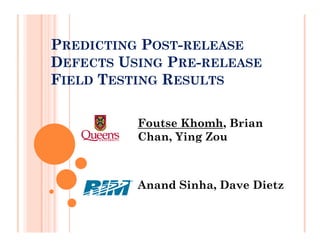
Reliability and Quality - Predicting post-release defects using pre-release field testing results
- 1. PREDICTING POST-RELEASE DEFECTS USING PRE-RELEASE FIELD TESTING RESULTS Foutse Khomh, Brian Chan, Ying Zou Anand Sinha, Dave Dietz
- 2. FIELD TESTING CYCLE Field testing is important to improve the quality of 2 an application before release.
- 3. MEAN TIME BETWEEN FAILURE Mean Time Between Failures (MTBF) is frequently used to gauge the reliability of the application. Applications with a low MTBF are undesirable 3 since they would have a higher number of defects
- 4. AVERAGE USAGE TIME AVT is the average time that a user actively uses the application. The AVT can be longer than the period of field testing. A longer AVT indicates that an application is 4 reliable and a user tends to use the application longer.
- 5. PROBLEM STATEMENT MTBF and AVT cannot capture the whole pattern of failure occurrences in the field testing of an application. 5 The reliability of A and B is very different.
- 6. METRICS We propose three metrics that capture additional patterns of failure occurrences: TTFF: the average length of usage time before the occurrence of the first failure, FAR: the failure accumulation rating to gauge the spread of failures to the majority of users, and OFR: the overall failure ratio that captures daily rates of failures. 6
- 7. AVERAGE TIME TO FIRST FAILURE (TTFF) VersionA % of users reporting failures 0.45 0.4 0.35 0.3 0.25 0.2 0.15 0.1 0.05 0 7 1 2 3 4 5 6 7 8 9 10 11 12 13 14 Days
- 8. AVERAGE TIME TO FIRST FAILURE (TTFF) VersionA VersionB % of users reporting failures 0.45 0.4 0.35 0.3 0.25 0.2 0.15 0.1 0.05 0 8 1 2 3 4 5 6 7 8 9 10 11 12 13 14 Days
- 9. AVERAGE TIME TO FIRST FAILURE (TTFF) reporting failures VersionA VersionB % of users 0.5 0.4 0.3 0.2 0.1 0 1 2 3 4 5 6 7 8 9 1011121314 Days TTFF produces high scores for applications where the majority of users experience the 9 first failure late.
- 10. AVERAGE TIME TO FIRST FAILURE (TTFF) VersionA VersionB 0.45 % of users reporting failures 0.4 0.35 0.3 TTFFB = 3.56 0.25 0.2 0.15 TTFFA = 6.11 0.1 0.05 0 10 1 2 3 4 5 6 7 8 9 10 11 12 13 14 Days
- 11. FAILURE ACCUMULATION RATING (FAR) 1 0.9 0.8 0.7 % of users reporting 0.6 0.5 VersionA 0.4 0.3 0.2 0.1 0 11 1 2 3 4 5 6 7 8 9 10 11 12 13 14 Number of unique failures
- 12. FAILURE ACCUMULATION RATING (FAR) 1 0.9 0.8 0.7 % of users reporting 0.6 0.5 VersionA 0.4 VersionB 0.3 0.2 0.1 0 12 1 2 3 4 5 6 7 8 9 10 11 12 13 14 Number of unique failures
- 13. FAILURE ACCUMULATION RATING (FAR) 1 % of users reporting 0.8 0.6 0.4 0.2 0 1 3 5 7 9 11 13 Number of unique failures The FAR metric produces high scores for 13 applications where the majority of users report a very low numbers of failures.
- 14. FAILURE ACCUMULATION RATING (FAR) 1 0.9 0.8 0.7 FARB = 4.97 % of users reporting 0.6 0.5 VersionA 0.4 FARA = 6.97 VersionB 0.3 0.2 0.1 0 14 1 2 3 4 5 6 7 8 9 10 11 12 13 14 Number of unique failures
- 15. OVERALL FAILURE RATING (OFR) VersionA 0.35 % of users reporting failures 0.3 0.25 0.2 0.15 0.1 0.05 0 15 1 2 3 4 5 6 7 8 9 10 11 12 13 14 Days
- 16. OVERALL FAILURE RATING (OFR) VersionA VersionB 0.35 % of users reporting failures 0.3 0.25 0.2 0.15 0.1 0.05 0 16 1 2 3 4 5 6 7 8 9 10 11 12 13 14 Days
- 17. OVERALL FAILURE RATING (OFR) % of users reporting VersionA VersionB 0.4 0.3 0.2 failures 0.1 0 1 3 5 7 9 11 13 Days The OFR metric produces high scores for 17 applications with fewer users reporting failures overall.
- 18. OVERALL FAILURE RATING (OFR) VersionA VersionB OFRB = 0.78 0.35 % of users reporting failures 0.3 OFRA = 0.93 0.25 0.2 0.15 0.1 0.05 0 18 1 2 3 4 5 6 7 8 9 10 11 12 13 14 Days
- 19. CASE STUDY We analyze 18 versions of an enterprise software application Overall 2,546 users were involved in the field testing The testing period lasted 30 days 19
- 20. SPEARMAN CORRELATION OF THE METRICS TTFF FAR OFR AVT MTBF TTFF 1 0.09 -0.08 -0.31 -0.08 FAR 0.09 1 0.07 0.33 -0.24 OFR -0.08 0.07 1 0.39 -0.54 AVT -0.31 0.33 0.39 1 -0.3 MTBF -0.08 -0.24 -0.54 -0.3 1 20
- 21. INDEPENDENCY AMONG PROPOSED METRICS 1 0.8 0.6 0.4 0.2 TTFF FAR 0 PC1 PC2 PC3 PC4 OFR -0.2 MTBF -0.4 -0.6 -0.8 21 -1
- 22. PREDICTIVE POWER FOR POST-RELEASE DEFECTS 0.14 0.12 0.1 Marginal R-square square 0.08 6 months 1 year 0.06 2 years 0.04 0.02 0 22 TTFF FAR OFR AVT MTBF Metrics
- 23. PRECISION OF PREDICTIONS WITH ALL FIVE METRICS 100 90 80 70 60 6 months 50 Precision (%) 1 year 40 2 years 30 20 10 0 23 5 10 15 20 25 30 Number of testing days
- 24. CONCLUSION TTFF, FAR, and OFR complement the traditional MTBF and AVT in predicting the number of post- release defects Provide faster predictions of the number of post- release defects with good precision within just 5 days of a pre-release testing period It takes MTBF up to 25 days to predict the number of post-release defects 24
- 25. 25
